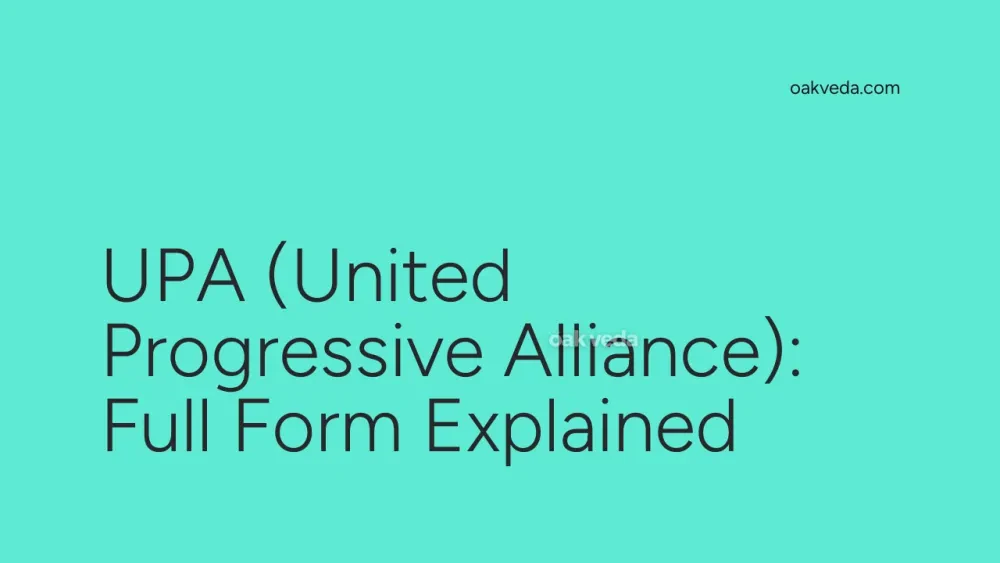
What is the Full Form of UPA?
The full form of UPA is United Progressive Alliance. This term primarily refers to a coalition of political parties in India, formed in the wake of the 2004 general elections. However, it's worth noting that UPA can also stand for United Productions of America in a different context, which we'll briefly touch upon later in this article.
What is United Progressive Alliance?
The United Progressive Alliance (UPA) is a coalition of center-left political parties in India. It was established when no single party secured an overall majority in the 2004 Indian general elections. The UPA has played a significant role in shaping Indian politics for over a decade, forming the government at the center from 2004 to 2014.
Origin and Development of UPA
The UPA was born out of political necessity in 2004. After the elections, the Indian National Congress (INC) emerged as the single largest party but lacked the numbers to form a government on its own. To counter the National Democratic Alliance (NDA) led by the Bharatiya Janata Party (BJP), the Congress forged alliances with various regional and left-leaning parties, giving birth to the UPA.
The alliance's formation marked a shift in Indian politics, emphasizing coalition-building and regional representation at the national level. Under the leadership of Dr. Manmohan Singh as Prime Minister and Sonia Gandhi as the UPA Chairperson, the coalition governed India for two consecutive terms until 2014.
How does the UPA work?
The UPA functions as a political coalition, with member parties coming together on a common minimum program. The alliance's working involves:
- Consensus Building: Member parties discuss and agree on key policy decisions.
- Power Sharing: Ministerial berths and important positions are distributed among alliance partners.
- Joint Campaigning: During elections, UPA parties often campaign together and support each other's candidates.
- Policy Formulation: The alliance works on creating policies that align with its center-left ideology.
Types of Parties in UPA
The UPA comprises various types of political parties:
- National Parties: Like the Indian National Congress
- Regional Parties: Such as the Rashtriya Janata Dal and Dravida Munnetra Kazhagam (formerly)
- Left Parties: Including the Revolutionary Socialist Party
- Identity-based Parties: For example, the Indian Union Muslim League
Functions of UPA
The primary functions of the UPA include:
- Forming and running the central government (when in power)
- Providing a united opposition (when out of power)
- Developing and implementing common policies
- Representing diverse regional and ideological interests at the national level
Applications of UPA in Indian Politics
The UPA model has several applications in Indian politics:
- Coalition Governance: Demonstrating how diverse parties can come together to form a stable government.
- Regional Representation: Bringing regional issues to the national forefront.
- Policy Implementation: Executing nationwide programs like the National Rural Employment Guarantee Act (NREGA).
- Political Bargaining: Showcasing the art of political negotiation and compromise.
Features of UPA
Key features of the United Progressive Alliance include:
- Ideological Flexibility: Accommodating various center-left and regional ideologies
- Strong Central Leadership: Typically led by the Indian National Congress
- Regional Diversity: Representing different states and regions of India
- Secular Outlook: Emphasizing inclusive and secular governance
Benefits of UPA
The UPA model offers several benefits to Indian politics:
- Inclusive Governance: Representing a wider spectrum of political ideologies and regional interests
- Policy Continuity: Maintaining consistency in national policies over multiple terms
- Checks and Balances: Alliance partners can act as checks on each other, potentially reducing the risk of power concentration
- National Integration: Bringing together parties from different regions, promoting national unity
Limitations or Challenges of UPA
Despite its successes, the UPA faces several challenges:
- Decision-Making Delays: Coalition politics can slow down the decision-making process
- Policy Compromises: The need to satisfy multiple alliance partners can lead to watered-down policies
- Political Instability: Disagreements between alliance partners can threaten government stability
- Corruption Allegations: The UPA government faced several corruption scandals during its tenure
Future Developments in UPA
The future of the UPA remains uncertain as of 2023. Key areas to watch include:
- Leadership Changes: Potential new leaders emerging within the Congress and other member parties
- Alliance Reconfigurations: Possible additions or departures of member parties
- Ideological Shifts: Potential adjustments in the alliance's political stance to counter other coalitions
- Regional Focus: Increased emphasis on state-level alliances and governance
FAQs on UPA Full Form
-
Who is the current chairperson of UPA? As of 2023, Sonia Gandhi continues to serve as the chairperson of the UPA.
-
When was UPA formed? The UPA was formed in 2004 after the Indian general elections.
-
How many terms did UPA govern India? The UPA governed India for two consecutive terms from 2004 to 2014.
-
What is the difference between UPA and NDA? While UPA is a center-left coalition led by the Congress, NDA (National Democratic Alliance) is a center-right coalition led by the BJP.
-
Is UPA currently in power? No, as of 2023, UPA is not in power at the central level in India.
It's worth noting that UPA can also stand for United Productions of America, an American animation studio active from the 1940s to 1970s. However, in the context of Indian politics, UPA invariably refers to the United Progressive Alliance.
You may be interested in:

